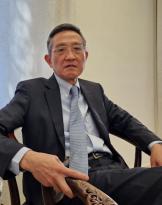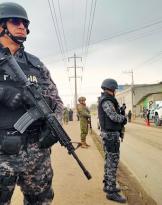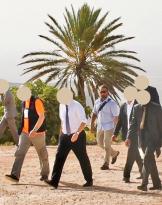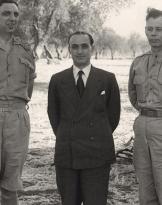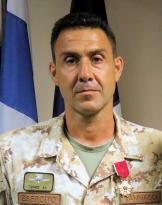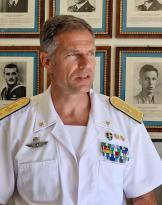Those born after the Cold War will think that the coolest military plane of those times was the Tomcat of the famous film "Top Gun", an icon of pop culture that blew up applications for enlistment in the Air Force Academies all over the world. As a simple witness I tell you that the forbidden dream of most of the boys was the A-10 Thunderbolt II.
Those were the years in which the dreaded "Pandemic" had the appearance of the end of the world for the tens of thousands of nuclear warheads or the end of western freedom for the tens of thousands of Soviet wagons at the gates of Europe: in the first case, common sense (reciprocal) and the film "The Day After" avoided the worst, in the second case one of the best "vaccines" was represented by a formidable flying tank destroyer nicknamed Warthog ( "Warthog").
The A-10 can attach rocket launchers, bombs and missiles (including anti-aircraft) to the 11 underwing pylons for over 7 tons, but the unique feature of this beast is the 30mm GAU-8 cannon Avenger (lit. "Avenger") which, with a rate varying from 2100 to 4200 rounds per minute (and a reserve of 1350 bullets), can still pass the armor of a tank from 6,5 kilometers away like butter.
Extraordinary "caser" (the pilot is protected by a titanium armor), the plane is known for having brought home the skin of many soldiers who would have had to eject with any other aircraft (see following photo).
Although in the CAS ("Close Air Support" role) the aircraft is now overtaken by the F-35, it remains the "Demon" that makes the unexpected nightmares of soldiers deployed on the ground in operational theaters disappear " hot "like the Afghan one.

Discovering over two years ago that one of our pilots, Captain Roberto Manzo alias "Pinna", was not only qualified but also in charge of a formation of A-10 of the United States Air Force (v.articolo), triggered constant requests for interviews with the Air Force press office.
Back in Italy and promoted to major, the pilot was finally able to satiate our curiosity ...
First of all, why the nickname "Pinna"? Did he do stunts with a Vespa as a boy?
Born and raised in Ostia, on the Roman coast, it was very common to grow up in groups in which funny and playful nicknames were used. I have never had a Vespa although I love riding motorcycles very much. My nickname, however, has nothing to do with my skills on two wheels but rather, alas, with the pronounced shape of my nose!
Shortly before I was assigned a callsign, that is the pseudonym with which pilots are commonly "identified" and which can often be read on flight suit patches and helmets, "fin" reached the ears of the older pilots of the 132nd Group. They could only confirm this nickname for me!
On how many aircraft is it enabled?
I have had the good fortune to fly with several aircraft during my career. I am enabled on SF-260AM and SF-260EA, T-37, T-38C, MB-339CD, AMX and AMX-T, A-10C, and recently on F-2000 and TF-2000.

The Warthog for those who grew up during the Cold War represented an absolute myth, especially for its ability to fire and to collect. How did you react to the opportunity to pilot it?
With great enthusiasm. When the Group commander called me to the office to tell me that I would leave for the United States to live this unforgettable experience, I couldn't believe it.
The Warthog is a myth, an icon, something completely different from any other set-up that can be found in operating theaters.
Having had the honor of piloting it and growing in the community as head of training and flight instructor is a satisfaction that I will carry with me for a lifetime.
Can you explain what the "pilot exchange" program is and what it is aimed at?
The Military Pilot Exchange Program is a bilateral agreement between the United States and other NATO partner nations that provides for the actual exchange of flight personnel for a shorter or longer period of time. In my case and in that of my US equivalent, the exchange lasted 4 years.
Throughout the exchange program, the "hosted" pilot is completely lowered in the guise of his host colleagues, and participates in the Group's flight and management activities with almost no distinction due to nationality. In my case, for example, I have studied and flown to take combat ready qualifications, couple head, training leader, and finally flight instructor, as well as the coveted "Sandy" qualification, typical callsign of CSAR missions (Combat Search) and Rescue).

From the group management point of view, however, I covered the roles of assistant training manager (in charge of the training section), chief of training (head of the training section), chief of scheduling (head of the flight activity planning section), and for two I have been Assistant Director of Operations for years.
At the end of the program, the pilot who has had the good fortune of having such an experience, returns to his country enriched with an important training and cultural background, both as a pilot and as an officer, to be shared as much as possible with his colleagues in his homeland.
The first time on board. What were the emotions when starting the turbines?
Although I arrived at the A-10C already as an expert pilot on other aircraft, the first flight is not something that is easily forgotten. The aircraft is really big to be a single-seater, and already climbing the ladder and getting into the cockpit, for me who came from the smallest and most agile AMX, puts a little awe.
There is no two-seater version of the Warthog, so unlike all the other planes with which I had flown before, the first time was immediately alone.
The noises, smells, vibrations that are heard at the first start-up, which certainly cannot be replicated in the simulator, raise adrenaline and level of attention to such an extent that you get off an hour and a half flight as if you had flown five hours!

In flight, what surprised and possibly what disappointed?
I knew that flight performance would be less than what I was used to, with less speed and thrust, so I can't say that I was disappointed. Instead, I was really surprised by the amount of state-of-the-art technology found in the cockpit.
The aircraft, from the outside, is almost exactly the same as the one in the green scales that flew 40 years ago, but inside the changes are truly radical. I was very impressed to realize how extremely performing the aircraft is despite its age.
Compared to the original aircraft, what and how many upgrades have there been over the decades?
The A-10C is constantly being updated, and the updates come with a really impressive speed. The aircraft has undergone major changes three times since I started flying there, until my last flight.
The improvements involved the ability to use a very wide variety of precision weaponry, both Laser and GPS, as well as mixed Laser-GPS, the introduction of laser-guided rockets, and radios particularly useful in locating isolated personnel for CSAR missions .
The aircraft is also equipped with an excellent datalink system, and the pilot has an HMCS (Helmet Mounted Cueing System) with which to direct the onboard sensors with the movement of the head. In short, the avionics part of the aircraft has nothing to do with that used during the first Gulf War.
Does the faceoff affect the flight?
The fact that the aircraft slows down during fire is actually a rumor. The aircraft has no limitations in this regard and like all other aircraft it continues to accelerate while firing.
The "myth" that the Warthog slows down I think stems from the fact that, if you were to fire on the ground with the engines off and without pressing the brakes, the recoil of the cannon would theoretically accelerate the aircraft "in reverse" up to about 40km / h .
 For years self-styled experts have filled pages writing that the F-35 would never equal the A-10 in the CAS. The tests carried out in recent years have blatantly denied those predictions. How is it possible?
For years self-styled experts have filled pages writing that the F-35 would never equal the A-10 in the CAS. The tests carried out in recent years have blatantly denied those predictions. How is it possible?
To respond adequately I feel the need to make a clarification. The A-10C is a "single role" aircraft, specializing in CAS, CSAR and FAC-A missions; the F-35 aircraft, on the other hand, is an "omni role" set-up, ie capable of performing multiple tasks usually assigned to different sets, and of doing it simultaneously. The Lightning II also acts as an "enabler", that is, it improves the operational capabilities of the structures able to communicate with it. The A-10 will be a more capable CAS set-up if flanked by an F-35, the F-15 will be a more capable striker if "connected" with an F-35, and so on.
The difference in concept is so marked as to make a comparison between the two aircraft really difficult. Although it does not have the infamous GAU-8 on board, does not have titanium protection around the cockpit, and does not usually carry with it the variety of armament typical of the A-10C, the F-35 is perfectly capable of effectively carry out missions in support of ground troops, thanks to the ability to use extremely advanced sensors, and to be connected not only with personnel on the ground, but also with the chain of command of operations.
In reality, the experts have never had any doubt about the enormous potential of the aircraft, and the tests have only confirmed it.
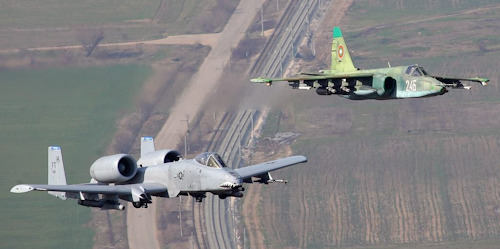 Have you met American colleagues who tried the Russian counterpart Su-25?
Have you met American colleagues who tried the Russian counterpart Su-25?
I had the opportunity to work with the Frogfoot in Bulgaria, at the Graf Iniatievo air base, during our deployment in Europe which lasted a few months.
The Su-25 has flight characteristics very similar to those of the A-10, if not superior in terms of thrust and speed, however in the avionics and armament part the difference between the two weapon systems was so abysmal as to not not even be comparable.
For how many years will the A-10 remain operational?
According to the latest reports and with the remaking of the wings, the Warthog will remain operational, although with constantly decreasing numbers, until at least 2030. However these are decisions that could change at any moment, and I would not know how to give a more precise answer than this.
The next dreams to achieve?
I have been back in Italy for about a year and started my new career on the Eurofighter Typhoon aircraft, returning to the 132nd Istrana Group, from where I started. In the meantime, my wife and I have become parents for the first time. I would say that the future promises very well!
I love the new aircraft and I am really happy to be able to get involved again, start over and reach maturity on a new machine.
My experience in the Air Force has taught me that with the commitment, determination and dedication to the service, great goals can be achieved. Up to now it has been so for me and I am really happy about it, as well as grateful for the opportunities that have been given to me.
Now I dream of continuing to improve and grow together with my Group colleagues, to reach the qualification of Instructor as soon as possible even on the Typhoon and maybe to have the honor, sooner or later, to fill the role of Group Commander.
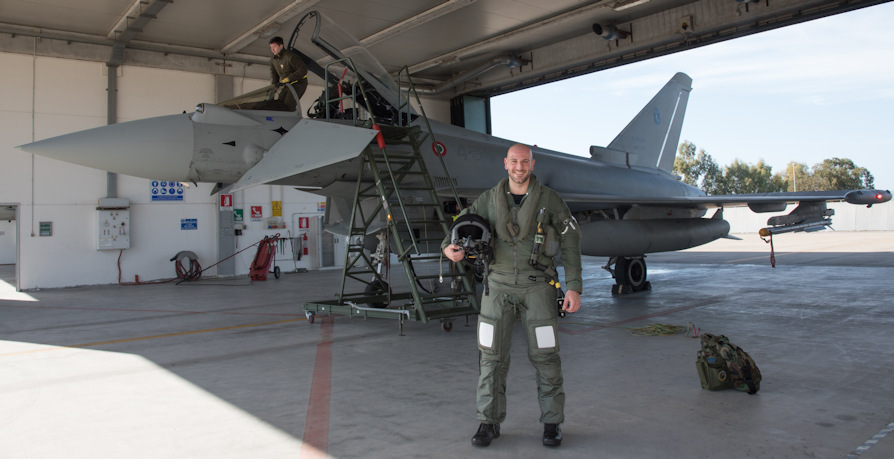
Photo: Aeronautica Militare / US Air Force / Bulgarian Air Force



